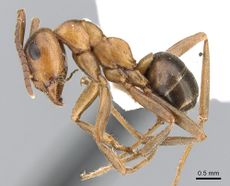Key to Formica subgenus Coptoformica workers of Europe
This worker key is based on: Seifert, B 2000a. A taxonomic revision of the ant subgenus Coptoformica Mueller, 1923 (Hymenoptera: Formicidae). Zoosystema. 22:517-568.
Seifert notes - For a successful use of setae characters, pay attention to remains or insertion points of detached setae.
You may also be interested in
1
- Eyes usually with conspicuous hairs, sometimes reduced in a big portion of specimens within a nest sample, but nest means of EyeHL (the length of the longest hair on the eyes including minute hairs visible at magnifications ≥ 150 ×)always > 8 μm . . . . . 2
- Eyes without or only with microscopically short hairs, nest means of EyeHL always < 8 μm . . . . . 4
2
return to couplet #1
- Standing setae usually beginning on the first or second gaster tergite, nest means of TERG 1.0-2.3. Scattered setae on clypeus usually distributed from anterior margin to center at least; nest means of ClySet 2.5-5. Craniad profile of forecoxae usually with numerous semierect setae; nest means of nCOXA 2.5-18 . . . . . Formica exsecta
- Standing setae usually beginning on the third or fourth gaster tergite; nest means of TERG 2.3-4.5. Setae on clypeus usually restricted to anterior margin and single second level setae (Fig. 3: brun; fenn); nest means of Clyset 1.0-2.0. Craniad profile of forecoxae without or only few semierect setae; nest means of nCOXA 0-1.5 . . . . . 3
3
return to couplet #2
- Pubescence in the ocellar region very dense (Fig. 4); nest means of sqrtPDF < 5.0. Pubescence on dorsum of first gaster tergite very dense; nest means of sqrtPDG < 6.9. Setae on outer edge of hind tibial flexor profile rather few and usually resticted to distal half (Fig. 2: brun); nest means of nHTFL < 5.5. Head not elongated and occipital corners less acute, nest means of CL/CW 1.033-1.065 . . . . . Formica bruni
- Pubescence in the ocellar region very thin (Fig. 4); nest means of sqrtPDF > 5.7. Pubescence on dorsum of first gaster tergite very thin; nest means of sqrtPDG > 6.9. Setae on outer edge of hind tibial flexor profile more numerous and usually distributed from apex to proximal third at least (Fig. 2: fenn); nest means of nHTFL > 5.7. Head usually elongated and occipital corners more acute (Fig. 1F), nest means of CL/CW 1.048-1.085 . . . . . Formica fennica
4
return to couplet #1
- Clypeal setae always restricted to anterior clypeus; nest means of ClySet 1.0-2.5 . . . . . 5
- Scattered setae always distributed from anterior margin to rear portion of clypeus, ClySet always > 3. Craniad profile of forecoxae with several semierect setae; nest means of nCOXA > 1.5. Head short and with more rounded sides and occipital corners (Fig. 1E), nest means of CL/CW 0.979-1.047. Ocellar region and dorsum of first gaster tergite with very dense pubescence, nest means of sqrtPDF 4.1-4.6 and of sqrtPDG 4.8-5.6. Outer edge of the hind tibial flexor side with several standing setae (Fig. 2: suec) . . . . . Formica suecica
5
return to couplet #4
- Standing setae beginning on first or second gaster tergite, nest means of TERG 1.0-2.0 . . . . . Formica forsslundi
- Standing setae usually beginning on third or fourth gaster tergite, nest means of TERG 2.3-4.5 . . . . . 6
6
return to couplet #5
- Clypeus lateral of the tentorial pit level without or only exceptionally with single pubescence hairs surpassing the anterior margin by more than 10 μm (Fig. 3: fore; press), ClyPub 0-1.5 . . . . . 7
- Clypeus lateral of the tentorial pit level with several pubescence hairs surpassing the anterior margin by more than 10 μm (Fig. 3: brun), ClyPub 1.5-6.5. Clypeus frequently with second level setae in addition to the first level setae, nest means of ClySet 1.0-2.3. Pubescence in the occellar region and on dorsum of first gaster tergite very dense; nest means of sqrtPDF < 5.0 and of sqrtPDG < 6.9 . . . . . Formica bruni
7
return to couplet #6
- Pubescence in the occellar region very dense (Fig. 4: fore); nest means of sqrtPDF < 5.20. Discriminant 0.52 sqrtPDF + 0.16 sqrtPDG -1.22 SL/CS -0.38 TERG < 1.14. Submeditterranean species of xerothermous grasslands . . . . . Formica foreli
- Pubescence in the occellar region very thin (Fig. 4: press); nest means of sqrtPDF > 5.20. Discriminant 0.52 sqrtPDF + 0.16 sqrtPDG -1.22 SL/CS - 0.38 TERG > 1.14. Subboreal-subalpine-continental species of semidry grasslands . . . . . Formica pressilabris


















